Facts About African leopard
The African leopard, scientifically known as *Panthera pardus pardus*, inhabits various regions across Africa, predominantly in sub-Saharan areas. Once widespread, their range has significantly fragmented due to habitat loss. Notably, despite earlier classifications identifying multiple subspecies, genetic studies have confirmed that all African leopards belong to a singular subspecies.
The coloration of their coat varies widely, from pale yellow to deep gold or tawny, often adorned with black rosettes and spots. Males are generally larger, weighing around 60 kg, while females typically weigh between 35-40 kg. Regional variations exist; for instance, leopards in the mountainous regions of the Cape Provinces may differ slightly in appearance from those found in other areas.
Leopards are exceptionally adaptable predators, predominantly hunting at night. Their diet is diverse, encompassing small animals to large ungulates. A remarkable behavior is their tendency to drag large kills into trees to protect them from scavengers. They thrive in a variety of habitats, from mountainous forests to savannahs, while avoiding extremely sandy deserts. Semi-desert regions pose the greatest risk due to scarce resources and conflicts with nomadic farmers.
The primary threats to African leopards stem from habitat loss and severe persecution, often linked to conflicts with livestock owners. Trophy hunting and human-wildlife conflicts further endanger their populations. However, conservation initiatives are in progress. The African leopard is listed in CITES Appendix I, providing it with the highest level of protection. Many protected areas, such as Etosha National Park and Kruger National Park, are dedicated to preserving these magnificent creatures.

 Mozambique
Mozambique